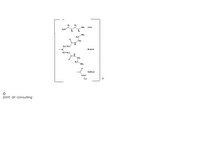 Tracking Products In Global Supply Chains With RFID, Radio-frequency identification
Tracking Products In Global Supply Chains With RFID, Radio-frequency identification
Date: June 9, 2005
Object: Low-Cost RFID (Radio Frequency Identification) “Labels”/”Tapes”/”Tags”/”Devices”
Inventor: xrd1 Consulting
Notebook #: © 2005 62005-2
Rights: Copyright/patent pending
Scope: To describe the invention/idea of a “label” (or “sticker”) made with a RFID (Radio Frequency Identification Device) and the potential benefits arising from this invention/device/embodiment.
The Invention: Would consist in the form of a “circuit” for a miniature – even microscopic – radio frequency emitter based on a conductive polymer. The conductive polymer compound would be based on dendritic-polymers coupled/”doped” with an electrically conductive metal ion or ligand. The compound would be applied as a liquid solution (or even a “melt”) through a stencil and then dried mechanically or even UV-light radiation cured. Stencil media and excess polymer compound would then be removed mechanically, chemically or otherwise. A “circuit” pattern of the cured compound would be left behind on a substrate. This miniature circuit could then be embedded in the currency paper during formation, or prior to printing, or after printing. In all cases, the miniature/microscopic emitter could be used individually (or combined with other similar emitters or with other technologies – such as bar-coding) to verify and authenticate any paper product, notes, currency that the micro-RFID Label was embedded in, stenciled on or otherwise applied to.
Alternately, the same process for applying the conductive polymer compound could be used as a tape form technology. Tape could then be applied anywhere in the process it allows.
Drawbacks: Technology is undeveloped and untested. Will power of the radio signal be sufficient to merit development based on size of the tag?
Benefits: Current RFID tagging technology is cost-prohibitive ($ 0.50 to $ 1.00 estimated per unit) and limits its application to “bulk” or “wholesale” level. A lower cost technology (described above) has the potential to drive technology cost down (for example, to $ 0.02 to $ 0.05 estimated per unit) and could be used at “retail” and “individual” or “mass-media” levels.
Potential for reduction counterfeit media entering in the USA cash flow and finance sector. “Immediate” physical verification (“counts”) and authentication of tendered/ received paper and paper currencies and all other media (“verification procedures”, “anti-counterfeiting strategies/initiatives”) and mitigation of law enforcement action concerning counterfeit media and paper and currency.
Potential for abatement of terrorist-funded activity via cessation and intercession of counterfeit media and currency (homeland security). Deprivation of terrorist-funded activity through use of RFID “tagged” media, paper and currencies.
Submissions: U.S. Bureau of Printing and Engraving, June 9, 2005
Brady Corp., June 20, 2005




No comments:
Post a Comment